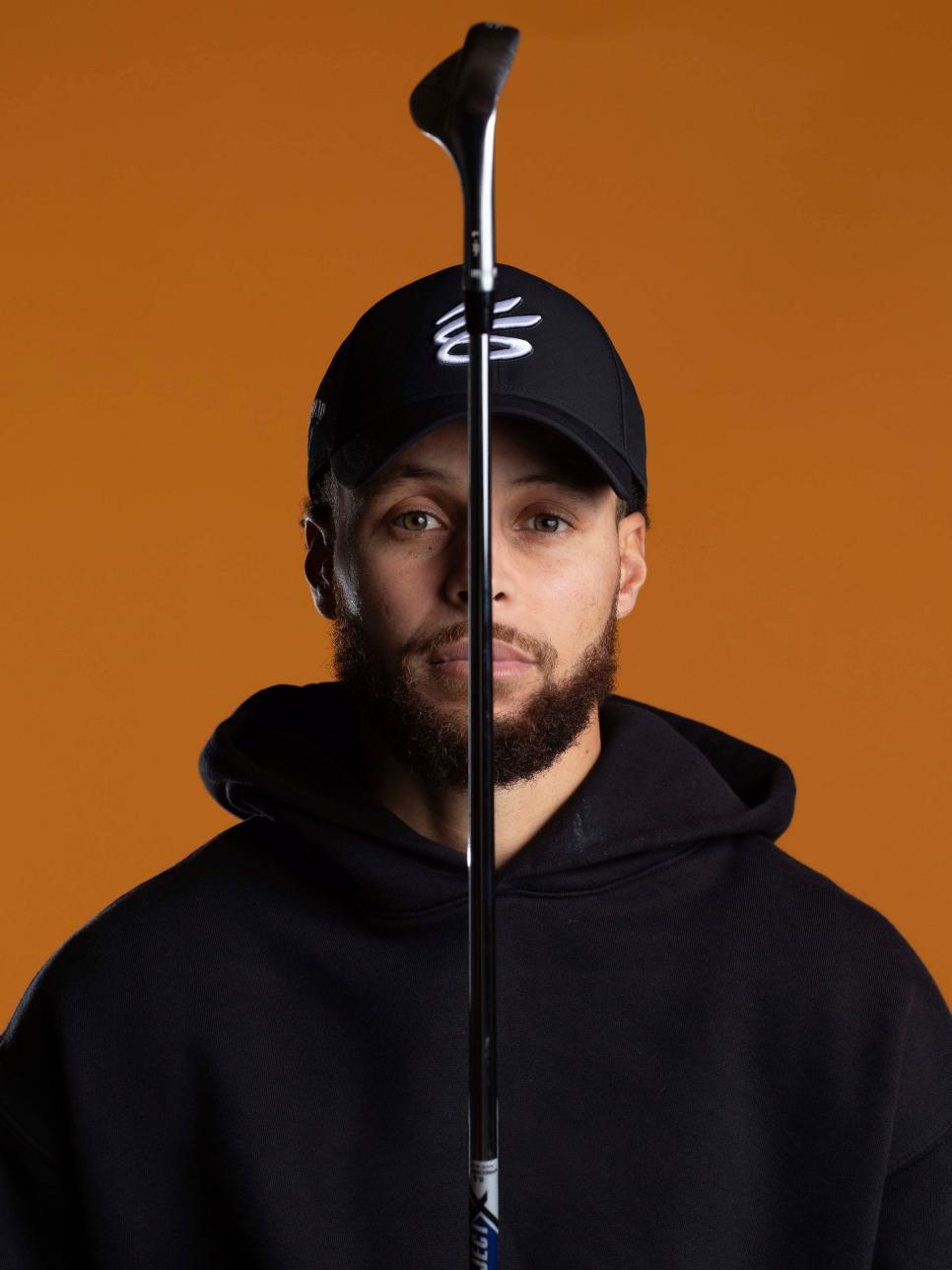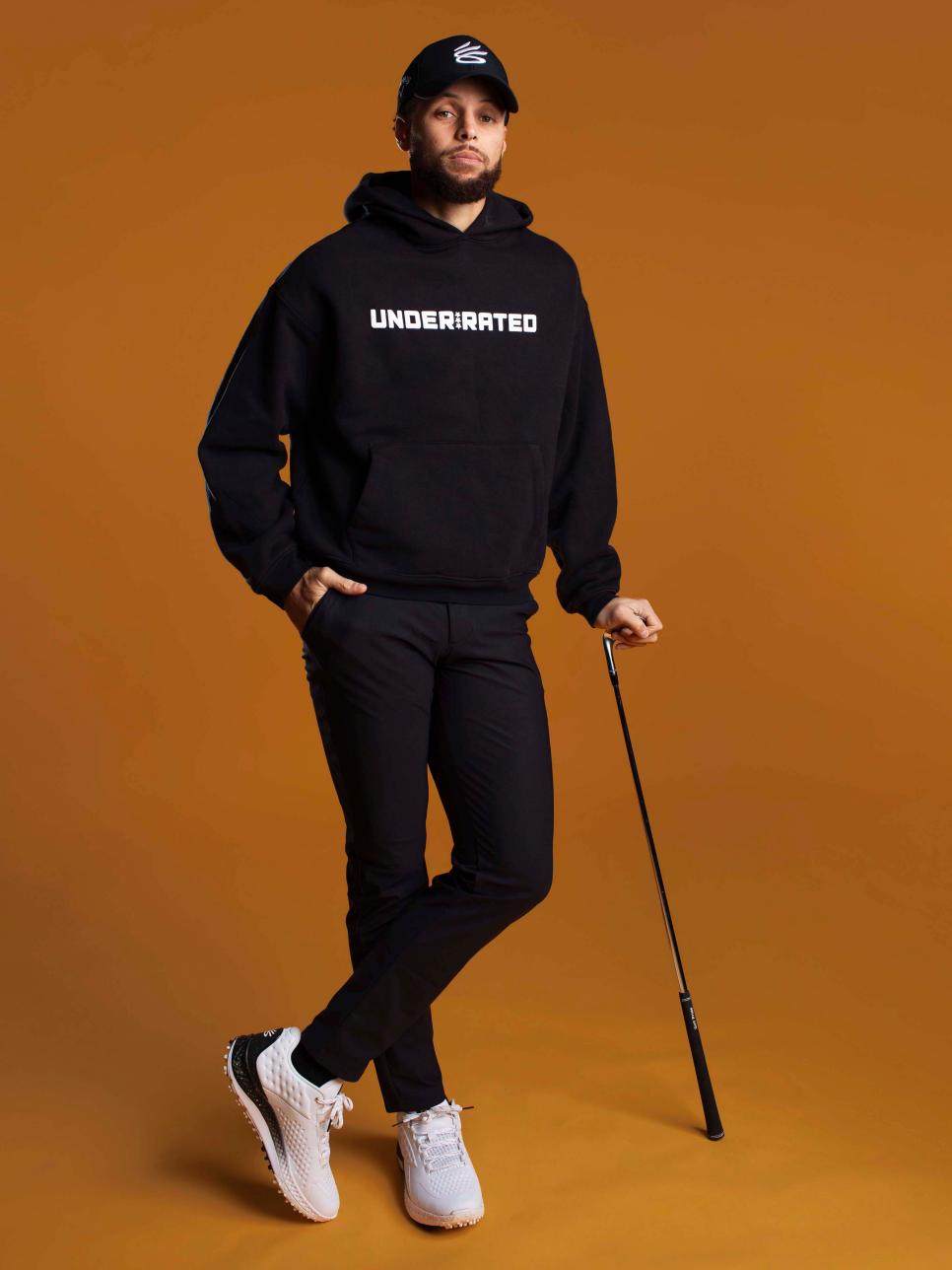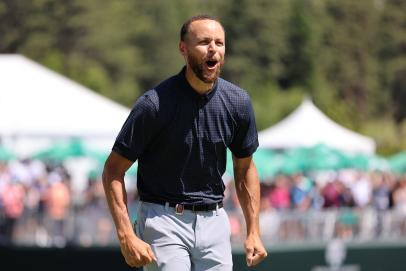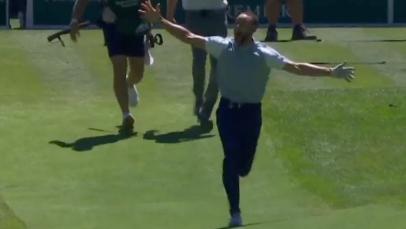We’re coming on three decades since Tiger Woods started shaking the world on its axis and inspiring kids in every neighborhood, and golf’s still as white as ever.
The number of Black pros at the highest level can be counted on one hand, and the elite amateur and college ranks don’t look much different. Several noble organizations have done great work introducing golf to kids who otherwise would not ever grip a club, but as far as keeping them in the game long enough to develop the skills and passion necessary to enter its flywheel of social connections, internships and careers—let alone play professionally—we’re basically flatlined.
.jpg.rend.hgtvcom.966.1288.suffix/1715700176805.jpeg)
To be sure, Tiger Woods’ cultural impact has been profound. The number of people of all feathers who play golf and/or regard it as a legitimate sport solely because of him is uncountable. Most criticism toward Woods’ lack of specific, deliberate action to diversify golf is simplistic. The sum of his choices led to the most dominant and thrilling golf ever played, and his TGR Foundation has delivered an impact commensurate with his star power in the realm of education. But golf’s other leaders might feel a missed opportunity. Not exactly a four-footer straight uphill to create ample access to driving ranges and courses in underserved communities, but it’s hard to imagine ever getting a better look than during the heart of Woods’ career.
The next in line with the greatest potential to make golf more closely resemble the makeup of our society plays point guard for the Golden State Warriors.
Really? Really.
As a basketball player, Stephen Curry, 36, reaches a wide demographic that pro golfers don’t. Winning the 2023 American Century Championship with a final-hole eagle during a summer when his handicap dipped as low as plus-3, Curry is the best celebrity golfer however you value skill against clout. Given his athleticism and competitive experience, his stated wish to one day play on the PGA Tour Champions isn’t ludicrous. “I don’t know what the path is,” Curry has said. “All I know is, when I’m done with basketball, I’m going to reasonably invest as much into my golf as I can to see how good I can get, and where that puts me 14 years from now, we’ll see.”
Curry’s various golf dreams, for himself and for others who look like him, are coming alive during a period of momentum like Tiger Woods never had. Golf is up for everybody post-pandemic, especially off-course driving ranges and simulator lounges in urban settings. According to the National Golf Foundation, green-grass participation among people of color is up a million in the past decade after suffering a small dip around 2018, but the real headline is there are 5.6 million new off-course golfers of color since the pandemic. That’s a big pool who could be inspired to get good at the real thing.
CURRY ROLLED UP TO THE GOLF DIGEST PHOTOSHOOT FOR this story in a Sprinter van with a deep entourage. After everyone got settled, which was easy at the commodious facility of the Stanford University golf teams, the first thing we did was record Curry’s swing on a GEARS biomechanical analysis system. Attaching all the reflective sensors correctly to the body takes a few minutes, during which the 6-foot-2 Curry humbly splayed his legs to bring his hazel gaze down to the median eye-level of our crew, who were also attaching audio microphones for a video. There’s a special strain of patience at being swarmed that only superstars possess, and Curry has it in buckets. Polite and relaxed, he said he was eager to “nerd out.” Amazingly, GEARS founder Michael Neff would uncover in Curry’s swing just a few minor aspects that stood apart from PGA Tour averages. “We’ve tested hundreds of tour players, and most of Stephen’s numbers were right there. I was floored.”

If they were playing a friendly match today, Jordan Spieth says he would spot Curry six strokes, maybe more on a difficult course, but long-term Spieth is no doubter. “He’d be one of the longest right away on the Champions tour,” Spieth says. “He’d rip up par 5s, so it’d come down to how tight can he get his game from 150 yards and in because you can’t miss on both sides of the flag out there. Obviously, he has the clutch gene, but what impresses me most is his joy. As long as he’s been playing basketball, it’s never seemed like work to him.”
PETTY OPPOSING FANS ASIDE, IT’S HARD TO FIND ANYONE serious who has a bad word about Curry. You hear “selfless,” “thoughtful” and “gracious” a lot, and hardworking and talented seem insufficient to describe the NBA all-time three-point scorer (3,729 swishes and counting) who was snubbed by top colleges as short and scrawny before eventually transforming the game with his shooting range, routinely attempting from eight and 10 feet behind the arc. Sure, his was a privileged childhood. Growing up the son of pro basketballer Dell Curry meant financial comfort and shootaround games with the Charlotte Hornets as a tween, but it’s an underdog’s journey that’s forged him. Before two league MVPs, four championship rings, 10 All-Star games and becoming a/the face of a major sport, Stephen’s defining moment was leading little Davidson to the Elite Eight when that college hadn’t won an NCAA tournament game in 39 years. The 2023 documentary chronicling this run, “Stephen Curry: Underrated,” produced by Curry’s own Unanimous Media, unavoidably contains some of the inherent bias of autobiography, but if a low seed ever needed to get pumped before a club championship, it’s a helluva watch.
To be underrated is to have low worth projected upon you by others—a depressing emotion most golfers typically handle all themselves—and capitalized it is the name of Curry’s “lifestyle brand.” The successful commercialization of this term is tied up with Curry’s chances to change golf.
Curry’s foundation, Eat. Learn. Play.—which has raised more than $52 million for meals, books, schools and playgrounds in the Oakland area—operates with its hand out like all charitable organizations whereas Underrated is for profit. It’s the name of a junior golf tour that’s landed heavy-hitting corporate sponsors, a basketball camp, a clothing line, and the future knows what else. In the scheme of Curry enterprises, which employs more than 70 people and gathers once a year for a multiday conference over which the man presides to hear presentations and realign dollars, the Underrated Golf Tour might be the purest example of the organization’s motto “purpose for profit.” In the fall of its second season in 2023, the Underrated Golf Tour’s ledger reached the black for the first time—$6 million in sponsor sales against about $4 million in operating expenses—according to Thirty Ink secretary/chairman Suresh Singh, a successful Ontarian real estate developer and longtime golf buddy of Dell Curry, and all profit is being reinvested to expand the tour.

THE CURRY CUP: Lucky Cruz and Roisin Scanlon, both 15, won the boys and girls competitions, respectively.
To those not familiar, the 2023 Underrated season comprised four tournaments across the United States for 48 boys and 48 girls ages 12 to 18, plus a season finale with a reduced field. The 2024 season will be the same, plus the launch of the tour’s European version at Walton Heath in London in May. For each event, only a handful of spots come via local qualifying, and so the costs—covering airfare, hotel, meals and transportation for every competitor as well as their parent and a special person, like a sibling or uncle or coach—rack up fast. However, being associated with Stephen Curry is regarded as good marketing, and aligning with his fledgling golf tour currently comes at a fraction of his normal rate. United Airlines credits most of the flights, Subway provides the lunches and corporations like KPMG and CDW supply ever useful cash. CSM, the entertainment agency that puts on several PGA Tour stops (providing signage, leaderboards, tents, logistics, etc.) runs the Underrated events and sends a bill. Curry started the tour with a personal check of $1.6 million amidst warnings he wouldn’t be able to find enough competitive golfers of color to make it legitimate. Indeed, a good deal of the initial cash was burned on recruiting missions to junior tournaments all over the United States. As much weight as Stephen Curry’s name carries, junior-tour operators have their own agendas, and many weren’t exactly eager to cough up the names and contact information of their best players to some voice calling on behalf of some new tour who wanted to steal them away.
I attended the Curry Cup season finale at Lake Merced Golf Club in San Francisco in August 2023. My experience was positive, and yet, with all risk of sounding tone deaf, it’s difficult to describe the shock of entering the guarded gates of a top private club and encountering a bustling scene in which whites are the minority. A DJ with full setup was pumping beats by the first tee, cycling through player requests for individual walkup music that ranged from Jay Z to Latino to Baby Shark. Nearly all the competitors were swagged out in Under Armour and Curry brand. In the gallery, dreadlocks and bold sneakers outnumbered gray combovers and penny loafers. Lots of collars, belts and tucked-in shirts, of course, but also No. 30 jerseys and gold jewelry. Digital leader boards and other grand buildouts amped the glory awaiting the winners who would shake hands with the tournament sponsors. Like basketball, football, track or any other sport with simpler access, here golf was presented as unabashed ambition: train, win, earn riches. If you want the opportunity, the Underrated Golf Tour doesn’t discriminate. A few of the kids looked like Eminem. Word.
CURRY’S GOLF DREAMS, FOR HIMSELF AND FOR OTHERS WHO LOOK LIKE HIM, ARE COMING ALIVE DURING A PERIOD OF MOMENTUM TIGER WOODS NEVER HAD
Sam Puryear, who coached golf at Stanford and Michigan State and is now the head coach at Howard University, and whose golf teams received a seven-figure donation from Curry in 2019, is, not surprisingly, a fan of Underrated. “This tour gives kids a chance to compete with no excuses plus second chances to learn to play under pressure, whereas the American Junior Golf Association [AJGA] is more one and done. It’s the difference between great intentions and great execution. Instead of just writing a check, Stephen shows up and gets to know these kids, and when you understand that one of the best athletes on the planet is behind you, you start to believe.”
Puryear’s father was a small-college All-American golfer in 1965 at what was then called Winston-Salem Teachers College. Despite a love for the game, the father never pushed his son into golf “because of the racial dimension. He had to deal with a lot of ugliness in and around country clubs,” Sam Puryear says. Nevertheless, Sam became a tournament player and went on to a life in golf. Puryear first met Curry 10 years ago in a little money game outside Charlotte organized through a mutual friend, Will Lowery. Fans of the Golf Channel reality show “Big Break” might remember Lowery as a competitor, but he’s now the lead recruiter for Underrated Golf Tour and its second-most influential visionary.
“Exposing a kid to golf is one thing, but it takes so much else to align for that kid to commit to the struggle to develop,” Lowery says. “Ideally, our tour removes at least the financial burden.” Although Lowery is mostly preoccupied with getting college scouts to attend Underrated events and securing more stars (points) for its winners to earn spots in AJGA events, he also works with Curry to line up speakers—successful people from the worlds of business, sports, entertainment and so forth who are walking illustrations of how the values and opportunities of golf can help any person advance. The idea is that for a 13-year-old, the lifelong reverberating power of a 30-second conversation with a hero can’t be overstated. As much as Curry, Lowery and the team want to graduate future PGA Tour pros, they’re also looking forward to the day when a former Underrated kid becomes CEO of some company and then supports the tour financially.
Behind this do-goodery is some interesting tension. How do you revolutionize the vibe of golf to make it more appealing to a new generation while respecting its traditions? Is it OK to use “dope” as an adjective when thanking a host for your experience at her country club? Is a hip-hop dance party on the main lawn an acceptable way to conclude a golf tournament? (Along with taco and sushi stations, the multicultural vibe at the Lake Merced Underrated Tour finale didn’t miss a beat.)
“It’s a delicate balance,” Curry says. “We want to create a fun environment that kids can see themselves in, but we also want our kids to know how to handle themselves and be respected and welcomed wherever they go. The traditions of golf are great for many reasons, but there’s also a modernization of the game going on right now, so there needs to be education on both sides.” Like any true golfer, Curry advocates knowing where you are. At certain courses, he enjoys rocking up in joggers and a T-shirt and playing music from his cart as he practices. At the California Golf Club, established in 1918 and where Curry’s a member, he usually arrives quietly mid-morning after getting his three kids off to school, perhaps with a stogie freshly lit, and walks and carries 90 percent of his rounds.

The horseshoe-shaped bar at the Cal Club is a famous hang, a windowless enclave of mahogany, leather chairs and gold-painted championship boards. For men of success, the classic reward would be to sink in here, start playing and fraternizing daily and see how many times you can get your name on the wall. Despite a physical training regimen of the highest order, Curry is no teetotaler. At heart, he’s a son of North Carolina, and his business relationship with Gentlemen’s Cut Bourbon isn’t just for show. He takes it neat or with a splash of soda and lemonade, and mischievously grins “I got a tolerance” when the topic turns to who can drink who under the table. With the grueling path of his basketball journey nearing its finish (working out after games, rehabbing his ankle, hours upon hours of crazy practice drills like dribbling tennis balls with both hands while alternating bouncing them against walls while wearing goggles in a fog-filled gym to simulate distraction), no one would think twice if Curry decided to slow down. But as it is, he has made a life where there’s rarely time to hang after golf. “Ideally there’s a little wiggle room to chill at the bar, but I’m usually straight to the trunk.”
With all Curry has cooking, he must be surrounded by effective people. Tiffany Williams, the chief operating officer of Thirty Ink, protects him from most administrative headaches. Jason Richards, Curry’s former teammate at Davidson whose own NBA career was short-lived, is the athletics operations director of the Underrated Golf Tour, which means he’s the central channel of communication for anxious golf parents. Kris Stone, vice president of relations and business development for Thirty Ink, a former Division I golfer and consigliere on all things golf, is usually the first text when Curry sends out “the bat signal” to get a tee time.
THIS JUNE DURING THE U.S. OPEN AT Pinehurst, Curry will accept the Charlie Sifford Award in recognition of his efforts to promote diversity in golf. Curry never met the man who broke the PGA Tour’s color barrier for tour cards and won two of its tournaments (Sifford died in 2015), but at the mention of the name Curry’s eyes glance skyward, then to the floor. “He’s a man who obviously did so much for creating opportunities within this game. I’m very humbled.”
Chris Womack, a Black golfer and CEO of Southern Company, which presents the award, draws a line right to Tiger Woods. “A lot of us were thrilled by all that Tiger has done and the barriers he broke down. We thought that would open the floodgates for African-Americans on tour, but there has not been that incredible groundswell. I love the work of The First Tee and love their core values, but if you’re going to prepare kids for the tour, they got to have the competition, and how Stephen Curry is providing that is deep work, not just a PR commitment.”
CAN THE UNDERRATED TOUR ACHIEVE IN GOLF WHERE DECADES OF STRATEGIZING AND RESOURCES DEPLOYED BY SMART PEOPLE HAVE COME UP SHORT?
Among the first to recognize Curry as a powerful agent of change in golf was Wendell Haskins, the veteran executive of several industries who recruited Curry to be an ambassador for PGA Jr. League in 2018. Haskins applauds the self-sustaining economics of Underrated. “These endeavors can’t just be based on charity. [Curry] is building brand affinity and future customers while doing something good. As to how many people of color ultimately become participants in the golf economy and can be traced to Underrated, that data will take years to materialize,” says Haskins, who would like to see Curry wield his influence to bring other celebrities to the cause. “Imagine if you had a dozen other athletes or entertainers doing at HBCUs what Stephen did at Howard?”
Therein lies another crux. The enormity of the task of cultivating meaningfully more Black and brown golfers in a world of yawning wealth gaps would seem to require much more than the effort of one, albeit extraordinary, person.
“I love what Stephen is doing, but I don’t think it fully solves player development,” says Dr. Michael Cooper, a longtime advocate who has had many high positions in golf, including chairman of the Golf 20/20 Diversity Task Force. “We need camps, academies, lessons, equipment, all over the country. It’s a very complex system. There are people who want to be the person to make it happen, but what we need is more collaboration and less overlap of services. Who’s going to be the leader to finally pull it all together? Could it be Stephen? Maybe.”
There’s a sentiment among some in pro golf that Curry should do more to enlist its players. One might counter that PGA Tour and LIV players have had plenty of time and opportunity to create junior programs at the scale of Underrated and might be better served addressing their own current fractures, but that’s to ignore the sincere pros and administrators whose help might be additive. One top agent told me: “The Underrated Golf Tour events are a first-class experience for players with great goodie bags, but with the right strategic partnerships the level of competition could get better. A lot of the money they’re spending on kids could be better spent working with existing organizations that are already in place to reach more kids.”
“For sure, there are a lot of collaboration opportunities,” says Curry, who’s quick to name the work of Notah Begay and Cam Champ. “A lot of guys have reached out to compliment me on what I’m doing, like Tony Finau, Justin Thomas. Collin Morikawa came to our event at Harding Park and spent the entire day. Jordan Spieth and Annika Sorenstam both opened access to their tournaments for Curry Cup winners. The number of kids who fit into this junior golf umbrella is huge, and we’re all just trying to reach who we can to give them access so that we can change some of those numbers in professional and college golf, as well as give them other tools outside the game, too.”
It has been a long time since a conquering hero from another sport tried to inspire a generation of Black golfers with such intention, but there is precedent. Joe Louis, heavyweight boxing champion of the world from 1937 to 1949, became the first Black person to play in a PGA-sponsored tournament at the 1952 San Diego Open. Louis told The New York Times: “I want people to know what the PGA is. We’ve got another Hitler to get by.” His son, Joe Louis Barrow Jr., later became a successful golf businessman and the first CEO of The First Tee (2000-’17).
Anything great in the world starts with a person and an idea, then gestates and develops from there. Can the Underrated Tour achieve in golf where decades of strategizing, effort and resources deployed by well-intentioned, smart people have come up short? Would Curry becoming the first pro athlete from another sport to earn a senior tour card or win a major elite amateur event even matter that much if the kids who idolize him don’t have access to competitive golf? Such answers won’t be known for many years. For now, a lot of Warriors fans might prefer their team captain put these dreams aside and focus on the other 14 guys on the roster after a humdrum season.
Every now and then, arrogance looks different in the rearview. Davidson basketball coach Bob McKillop had patience when a scrawny freshman started chucking threes from 10 feet behind the line.
More On Steph Curry  Golf Guy A timeline of Steph Curry’s most golf-obsessed moments
Golf Guy A timeline of Steph Curry’s most golf-obsessed moments  Celebrity Golfers Watch Stephen Curry make a walk-off eagle to win the American Century Championship
Celebrity Golfers Watch Stephen Curry make a walk-off eagle to win the American Century Championship  Be like Steph Watch Steph Curry make a hole-in-one, and his GOAT celebration will be replayed for decades
Be like Steph Watch Steph Curry make a hole-in-one, and his GOAT celebration will be replayed for decades
This article was originally published on golfdigest.com

